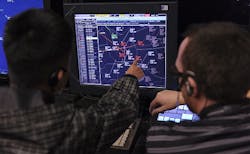Harris shows airborne surveillance, self-protection, and electronic warfare systems in Paris
CorvusEye 1500 wide-area airborne surveillance system, which complements traditional video surveillance systems by providing high-resolution, visible color and infrared motion imagery over a wide area up to 1.24 miles in diameter. CorvusEye can generate up to 10 high-resolution views of different areas of interest simultaneously and is exportable to many military, intelligence and security agencies around the world.
Spokesperson: Dwight Greenlee, Director, Regional Persistent Surveillance
Electronic warfare capabilities that are critical to airborne operators and other aerospace systems:
Disruptor SRx, a newly debuted adaptive, multifunctional EW capability with industry leading size, weight and power characteristics for mission success in a constantly changing electronic environment.
ALQ-211, a family of electronic self-protection systems, including the suite of integrated radio frequency countermeasures (SIRFC), which protects Army Special Forces rotorcraft from sophisticated radio frequency (RF) threats.
Advanced Integrated Defensive Electronic Warfare Suite(AIDEWS) is an integrated radar warning receiver and radio frequency (RF) jammer that provides electronic countermeasures against modern airborne and ground-based RF threats. AIDEWS is offered in an internally installed (V)4 configuration, as well as in an external, hard-point fitted (V)9 pod. The air forces of Oman, Chile and Poland all fly the combat capable (V)4, while Pakistan and Turkey have both the (V)4 and the (V)9 for their new and legacy F-16s.
AN/ALQ-214 IDECM Radio Frequency Countermeasure (RFCM) is the self-protection and mission enabling EW system for the U.S. Navy’s combat aircraft – the F/A-18E/F, C/D. This design, along with the ongoing software technology roadmap, ensures the U.S. Navy’s aircraft will be protected and effective against current and future threats.
Spokesperson: Andy Dunn, VP, Busniess Development, Integrated Electronic Warfare Systems
Advanced aerostructures composites materials for lightweight commercial aircraft
Spokesperson: Mike Blair, vice president and general manager, Aerostructures
Small and light-weight carriage, release and interfacing systems are designed for use on several types of unmanned aerial vehicle (UAV) platforms. These systems enable both fixed wing and rotary UAVs to deliver a wide range of payloads for all types of missions. These include single and multiple store payloads for both military and civil applications that range in weight from a light five pounds to as much as 1,450 pounds.
Spokesperson: Nick Guard, business development manager, Night Vision & Communications Systems



